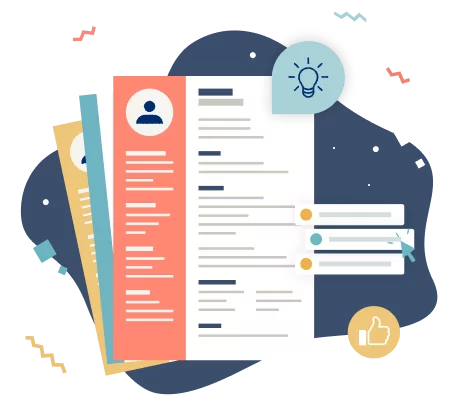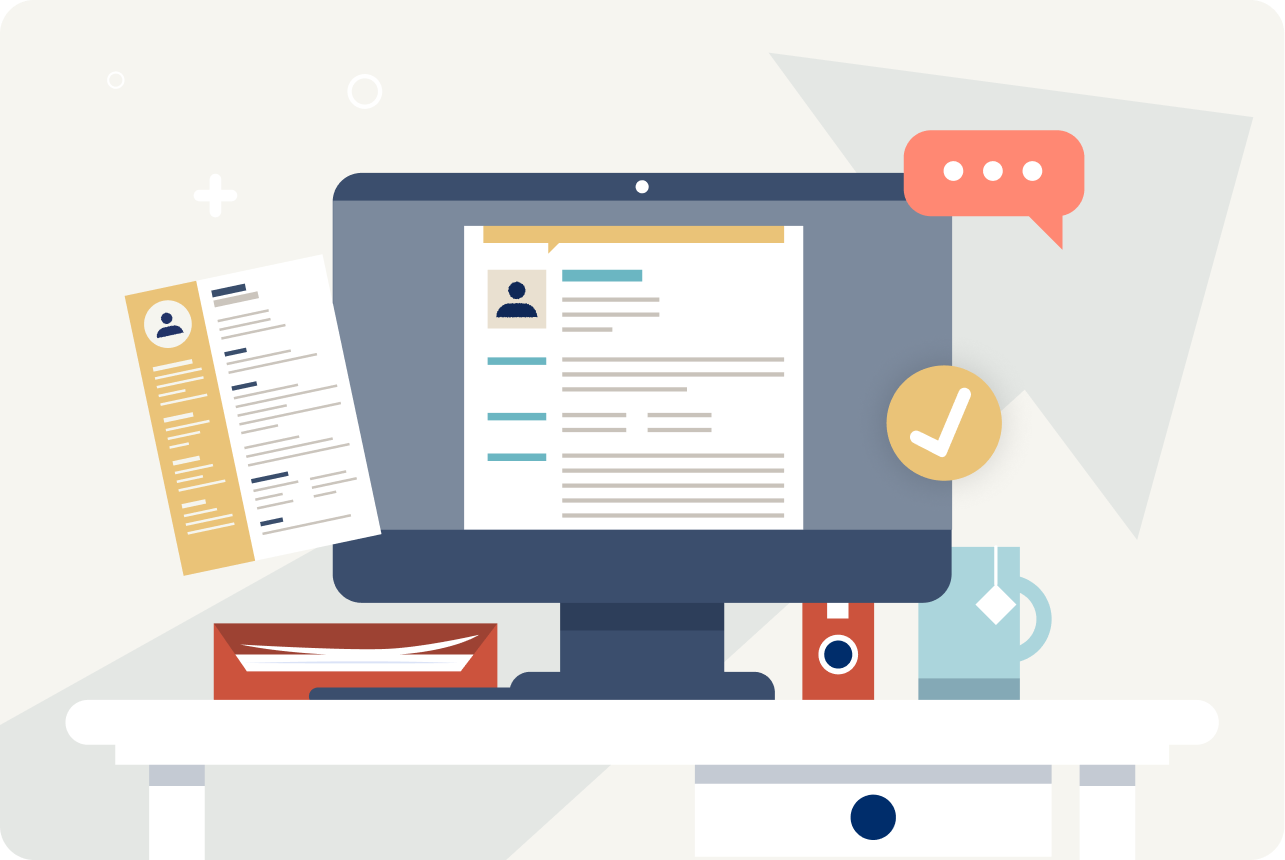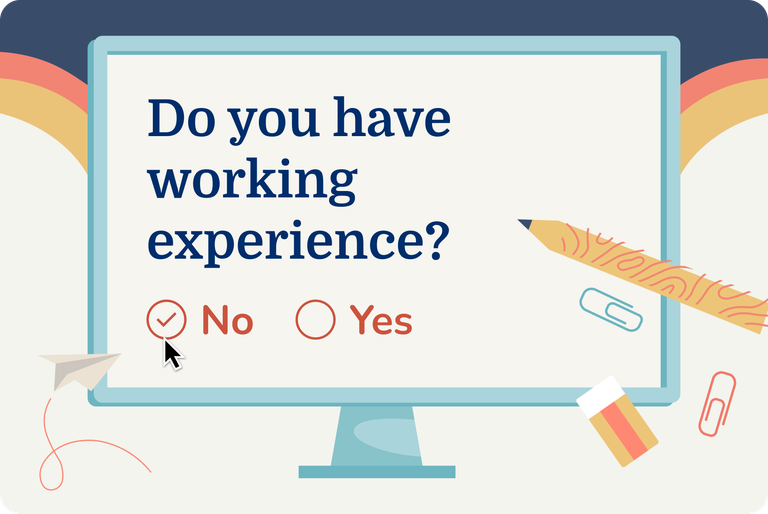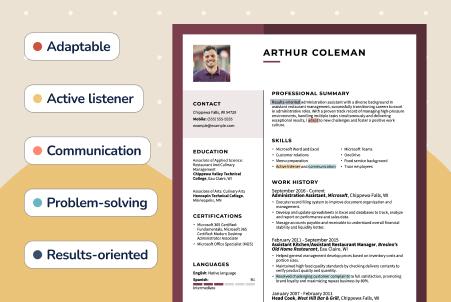How to Write an Effective Resume Work Experience (With Examples)

Our customers have been hired at: *Foot Note
Your resume is your personal marketing tool, and the work experience section? That’s the heart of the pitch.
It’s where you show employers exactly what you’ve done, how well you’ve done it, and why you’re the perfect fit for the role. But how do you make your experience stand out without sounding like everyone else?
Jump to the following sections:
How to Describe Work Experience on a Resume
Your work experience resume section is key to showing the hiring manager you're the right candidate. In this section, the reader can see what you've accomplished and how your career has grown.
Follow these steps to create an impressive work history resume section:
STEP 1
Prepare your information
Before you start writing your resume, gather all the information you need to craft a perfect work history. Here’s what you should look for:
- Make a list of your past employers, job titles and responsibilities.
- Focus on your last one to 10 years of employment. If you don't have formal work experience, consider other relevant experience, such as internships, volunteer activities, community service work, or academic or personal projects.
- Make note of what you achieved for each job and key skills you learned.
- Consider what you're most proud of from your past job experiences. Be specific about how you tackled challenges and describe the positive impact of your actions.
STEP 2
List your work experience in reverse-chronological order
Next, organize your work history starting with your current or most recent job and working backward chronologically. This will better showcase your career progression.
STEP 3
Add essential information about each job you held
For each job, display, in order:
- Your job title.
- The company name, city and state.
- The dates you were employed.
STEP 4
Showcase three to five achievements for each job experience
To make your work history section stand out, displaying your job responsibilities is not enough. Instead, show potential employers what you can do for them by showcasing your professional accomplishments.
Add three to five measurable achievements for each job. Hiring managers spend less than a minute reviewing a resume, so use bullet points to make your accomplishments concise and easy to find.
Compare the difference between a work experience section without accomplishments vs one with multiple measurable achievements:
New York, NY | June 2020 – Present
Designed marketing assets for client’s social media platforms.
Collaborated with the marketing team to create a rebranding campaign for a key client.
Streamlined the design process by implementing new design software.
New York, NY | June 2020 – Present
- Designed and launched over 50+ marketing assets for clients, resulting in a 30% increase in engagement across social platforms.
- Collaborated with the marketing team to create a rebranding campaign for a key client, which led to a 25% boost in brand recognition and a 15% increase in customer retention.
- Streamlined the design process by implementing new design software, cutting production time by 20% and improving overall team efficiency.
How to Choose a Resume Format For Your Work Experience
Every resume format has a work experience section but each displays it differently, depending on your goals. Consider what you want to highlight on your resume before selecting one of the following formats:
Chronological resume
The chronological resume format is the most commonly used among professionals.
A chronological resume places your work history in resume prominently at the top, just below your resume summary.
It's ideal for candidates with a long employment history — more than eight or 10 years of work experience — and no employment gaps.
Here's an example of a chronological resume:
Functional resume
Functional resumes are well-suited to job seekers applying for their first job and applicants with gaps in their job history because they spotlight skills over work experience.
As you can see from our functional resume example, this format includes a work history section but it is short and appears just below the skills section.
Here's an example of a functional resume:
Combination resume
Whether you’re a seasoned veteran or a recent graduate, our resume templates can help you jump-start your resume writing journey.
Work Experience Examples for Different Career Levels
Our resume analysts wrote work experience resume samples to help you learn how to write work experience in a resume, regardless of your career level.
Entry-level
Food Server | Burger Shack Unlimited
Newark, NJ | 2020 – Present
- Greet up to 40 customers per hour and take accurate orders on the register for menu items.
- Prepare food items for a menu of 36 dishes using restaurant-supplied recipes by correctly measuring ingredients and mixing items.
- Use the POS system to calculate customer food order totals and take payment for more than 50 cash and credit card transactions per day.
- Deliver friendly customer service to hundreds of customers daily and address their concerns when needed.
- Follow all proper on-the-job safe food-handling procedures and cleaning regulations when working with raw ingredients and serving.
Mid-career level
Senior Copywriter | The Art of Digital Content
Anaheim, CA | 2018 - Present
- Create high-impact messaging for all marketing media, contributing to a 35% increase in revenue and market share.
- Provide editorial guidance to other four cross-functinal departments, including the marketing team, ensuring the delivery of top-quality content.
- Authored online display ads that drove click-conversion rates of 2.35% in two months.
Copywriter | The Art of Digital Content
Anaheim, CA | 2013 - 2018
- Edited 100+ pieces of content produced by senior executives, modifying the text to conform to company-wide branding standards and publication guidelines.
- Wrote advertising copy for online content, adhering to employers' overarching brand identity and personality, and increasing click-through rates by 25%.
- Incorporated between 11.5k and 30.3k SEO keywords into copy to increase search result rankings, producing high conversion rates.
Experienced level
Senior UI/UX Designer | TechSphere Innovations
San Francisco, CA | January 2016 – Present
- Lead the design and implementation of 15+ mobile and web applications, resulting in a 25% increase in user engagement and a 30% reduction in bounce rates.
- Spearhead a comprehensive redesign of the company’s flagship product, increasing user retention by 20% within the first six months post-launch.
- Establish a design system that improved cross-functional collaboration and reduced design cycle time by 40%.
UI/UX Lead | PixelCraft Studio
Seattle, WA | May 2010 – December 2015
- Directed a team of five designers to create intuitive interfaces for 10+ client projects, achieving a 98% satisfaction rate in client feedback surveys.
- Designed an e-commerce platform that increased conversion rates by 35% and earned an award for innovation in digital retail.
- Developed A/B testing strategies that optimized product design, resulting in a 22% improvement in task completion rates.
UI/UX Designer | Bright Ideas Agency
New York, NY | June 2008 – April 2010
- Designed and prototyped user interfaces for 20+ websites, contributing to a 15% average increase in client revenue post-launch.
- Conducted user research and usability testing for multiple projects, reducing average user pain points by 25%.
- Implemented responsive design practices that boosted mobile traffic by 40% across all projects.
Tips for a Perfect Work History
- Use standard job titles: Ensure that your job titles are commonly recognized and match the title of the job you are applying for or job titles typically used in your industry.
- Include relevant keywords: Boost your resume with keywords and phrases that match the job requirements and increase your chances of passing ATS.
- Use bullet points: Organize your work history with bullet points to make it easier for the ATS to scan and extract relevant information.
- Quantify your achievements: Where possible, include numbers that show the impact of your accomplishments.
- Use action-oriented language: Start each entry with a strong action verb to reduce wordiness and convey proactiveness.
Advice for Unique Work Experiences
Crafting work history section can be particularly challenging when you have a unique job history, such as employment gaps, lack of traditional experience, or a career change.
In these situations, you must be strategic when highlighting your skills, accomplishments and potential to prospective employers.
Here we provide guidance and tips for navigating unique work situations so your job history spotlights your strengths and suitability for the desired role.
Employment gaps
We highly recommend using the combination resume format in this situation because it will put equal importance on your work experience and skills, so the gap won’t be as noticeable.
If your employment gap was longer than a year, you can include what you were doing during that time as part of your work experience — but only do this if you gained relevant skills or training and be brief. For example, maybe you cared for your family, volunteered with a local organization, earned a relevant certification, or picked up a gig.
Here's an example of how to write a resume work experience section if you have employment gaps:
First job
When you don’t have work experience, think outside the box.
Were you in any relevant internships? Do you have a personal project that relates to the job you are applying to? Were you involved in an extracurricular activity that gave you important skills and experience? Did your school club arrange fundraising events or donation drives?
All of these can be written in your resume — they’re valuable!
Consider using a functional resume that centers around your skills and strengths. It will help you show the hiring manager that you’re a well-rounded candidate with great potential.
Here's how to make a resume with no work experience:
Career change
Updating a resume for a career change is all about highlighting transferable skills and relevant job experience to make a connection between your previous jobs and your new career path.
Read the job description carefully and match your current skills to the required skills in the ad.
Consider switching your professional summary to a resume objective to market yourself as the best candidate for the job.
The following is a good example of a resume for a career change:
How to Include Freelance, Contract or Gig Work Experience
Don’t hide your short-term projects! Display them with your traditional full-time jobs or create a separate section for them in your job history section.
Incorporating freelance, contract, or gig work into your work experience section demonstrates your versatility and showcases the valuable skills you gained in today's gig-based workforce.
Here are some tips on how to effectively include this type of work:
- Use clear labels: Indicate whether the position was freelance, contract, or gig work.
- Highlight key projects and clients: Showcase specific projects you worked on and the clients or companies you collaborated with. Include details about the scope of the projects, your role and any notable achievements.
- Quantify your results: Whenever possible, quantify the impact of your freelance, contract, or gig work by including metrics or results achieved. This could include metrics such as revenue generated, cost savings, or project completion time.
- Emphasize your transferable skills: Highlight the transferable skills you developed through your freelance, contract, or gig work relevant to the position you are applying for.
Resume Work Experience Examples by Job Title
Our career advice experts created resume examples for current trending job roles to give you ideas for presenting your work experience and other key resume sections:
Key Takeaways
To wrap up, let’s quickly go over what we discussed in this article:
- In your resume’s job history section, follow standard formatting: job title, company name, company location, and dates of employment.
- Recap your work experience with three to five bullet points per job.
- Start each bullet point with an action verb.
- Tailor each job experience you’re listening to the job you’re applying to.
- Highlight achievements instead of everyday tasks and include numbers when possible.
- Each resume format highlights work experience differently, so choose the one that best presents your experience and skills.
- If you don’t have work experience, it’s acceptable to use internships, community service, volunteer work and academic or personal projects that demonstrate your ability to perform the job you want.
FAQ
How many years of work history should be on a resume?
The ideal number of years of work experience on a resume typically ranges from 10 to 15 years but can vary.
Prioritize recent and relevant work experience while ensuring that the overall length of your resume remains concise and focused on highlighting key qualifications and achievements.
Ultimately, the goal is to showcase a strong and comprehensive overview of your professional background that aligns with the requirements of the job you are applying for.
How do you write a resume with no work experience?
Writing a resume with no work experience can be challenging, but it’s important to remember that employers understand that entry-level candidates may not have a lot of professional experience.
Here are some tips for writing a strong resume with no work experience:
- Focus on your education and academic achievements. List your degree, major, GPA, relevant coursework and any academic honors or awards. You can also include any relevant skills or certifications you gained through your education.
- Highlight your relevant skills and accomplishments. Even without work experience, you may have developed skills through volunteering, internships or extracurricular activities. Include any relevant skills, such as communication, teamwork, leadership or problem-solving.
- Include any relevant experience, even if it’s not paid work. This could include volunteer work, internships or freelance projects.
- Remember to keep your resume concise and focused, and use a simple and easy-to-read format.
Which work experience is listed first on a resume?
We recommend you to start with your most recent or current position when listing your work experience on your resume. This reverse chronological order allows potential employers to see your most recent roles and accomplishments quickly, providing a clear overview of your career progression.
What is a stable work history?
A stable work history refers to a professional record where an individual has consistent employment over a while, typically characterized by:
- Longer tenures: Spending several years with the same employer (e.g., 3+ years in one role or organization).
- Fewer gaps: Minimal or no unexplained employment gaps between jobs.
- Progression: A logical progression in job titles, responsibilities, or industries, showing career growth and development.
- Consistency in the field: Working in the same or related industries, demonstrating commitment and expertise in a specific area.
However, a less stable history (e.g., shorter job tenures or frequent career shifts) can be framed positively if it highlights diverse experience, adaptability, or purpose-driven decisions.
How we reviewed this article
Since 2012, we have helped more than 11 million job seekers. We want to make your career journey accessible and manageable through our services and Career Center’s how-to guides and tips. In our commitment to bring you a transparent process, we present our Editorial Process.
Sources
- Drexel University. Article. How to Describe Your Work Experience
- Finances Online. 10 Current Resume Trends & Forecasts for 2024 You Should Be Thinking About
- Forbes. Article. Hudson, James. A Recruiter’s Guide to Writing a Resume
Our customers have been hired at:*Foot Note











